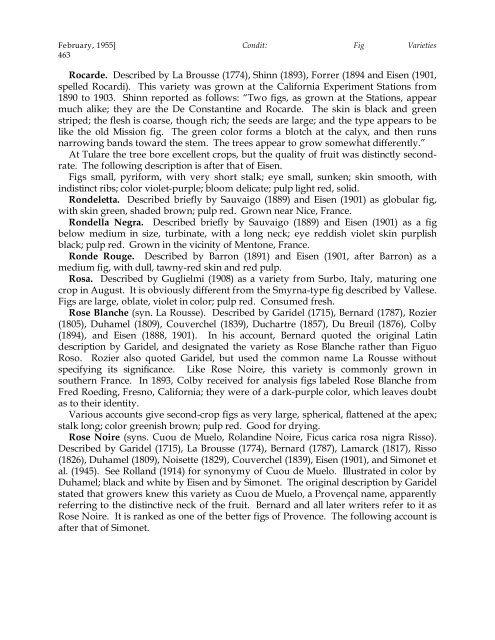Fig Varieties: A Monograph - uri=ucce.ucdavis
Fig Varieties: A Monograph - uri=ucce.ucdavis
Fig Varieties: A Monograph - uri=ucce.ucdavis
Create successful ePaper yourself
Turn your PDF publications into a flip-book with our unique Google optimized e-Paper software.
February, 1955] Condit: <strong>Fig</strong> <strong>Varieties</strong><br />
463<br />
Rocarde. Described by La Brousse (1774), Shinn (1893), Forrer (1894 and Eisen (1901,<br />
spelled Rocardi). This variety was grown at the California Experiment Stations from<br />
1890 to 1903. Shinn reported as follows: “Two figs, as grown at the Stations, appear<br />
much alike; they are the De Constantine and Rocarde. The skin is black and green<br />
striped; the flesh is coarse, though rich; the seeds are large; and the type appears to be<br />
like the old Mission fig. The green color forms a blotch at the calyx, and then runs<br />
narrowing bands toward the stem. The trees appear to grow somewhat differently.”<br />
At Tulare the tree bore excellent crops, but the quality of fruit was distinctly secondrate.<br />
The following description is after that of Eisen.<br />
<strong>Fig</strong>s small, pyriform, with very short stalk; eye small, sunken; skin smooth, with<br />
indistinct ribs; color violet-purple; bloom delicate; pulp light red, solid.<br />
Rondeletta. Described briefly by Sauvaigo (1889) and Eisen (1901) as globular fig,<br />
with skin green, shaded brown; pulp red. Grown near Nice, France.<br />
Rondella Negra. Described briefly by Sauvaigo (1889) and Eisen (1901) as a fig<br />
below medium in size, turbinate, with a long neck; eye reddish violet skin purplish<br />
black; pulp red. Grown in the vicinity of Mentone, France.<br />
Ronde Rouge. Described by Barron (1891) and Eisen (1901, after Barron) as a<br />
medium fig, with dull, tawny-red skin and red pulp.<br />
Rosa. Described by Guglielmi (1908) as a variety from Surbo, Italy, maturing one<br />
crop in August. It is obviously different from the Smyrna-type fig described by Vallese.<br />
<strong>Fig</strong>s are large, oblate, violet in color; pulp red. Consumed fresh.<br />
Rose Blanche (syn. La Rousse). Described by Garidel (1715), Bernard (1787), Rozier<br />
(1805), Duhamel (1809), Couverchel (1839), Duchartre (1857), Du Breuil (1876), Colby<br />
(1894), and Eisen (1888, 1901). In his account, Bernard quoted the original Latin<br />
description by Garidel, and designated the variety as Rose Blanche rather than <strong>Fig</strong>uo<br />
Roso. Rozier also quoted Garidel, but used the common name La Rousse without<br />
specifying its significance. Like Rose Noire, this variety is commonly grown in<br />
southern France. In 1893, Colby received for analysis figs labeled Rose Blanche from<br />
Fred Roeding, Fresno, California; they were of a dark-purple color, which leaves doubt<br />
as to their identity.<br />
Various accounts give second-crop figs as very large, spherical, flattened at the apex;<br />
stalk long; color greenish brown; pulp red. Good for drying.<br />
Rose Noire (syns. Cuou de Muelo, Rolandine Noire, Ficus carica rosa nigra Risso).<br />
Described by Garidel (1715), La Brousse (1774), Bernard (1787), Lamarck (1817), Risso<br />
(1826), Duhamel (1809), Noisette (1829), Couverchel (1839), Eisen (1901), and Simonet et<br />
al. (1945). See Rolland (1914) for synonymy of Cuou de Muelo. Illustrated in color by<br />
Duhamel; black and white by Eisen and by Simonet. The original description by Garidel<br />
stated that growers knew this variety as Cuou de Muelo, a Provençal name, apparently<br />
referring to the distinctive neck of the fruit. Bernard and all later writers refer to it as<br />
Rose Noire. It is ranked as one of the better figs of Provence. The following account is<br />
after that of Simonet.
















![Fig Trees in North Carolina [Archive] - IDigMyGarden ... - Figs 4 Fun](https://img.yumpu.com/26905320/1/190x245/fig-trees-in-north-carolina-archive-idigmygarden-figs-4-fun.jpg?quality=85)